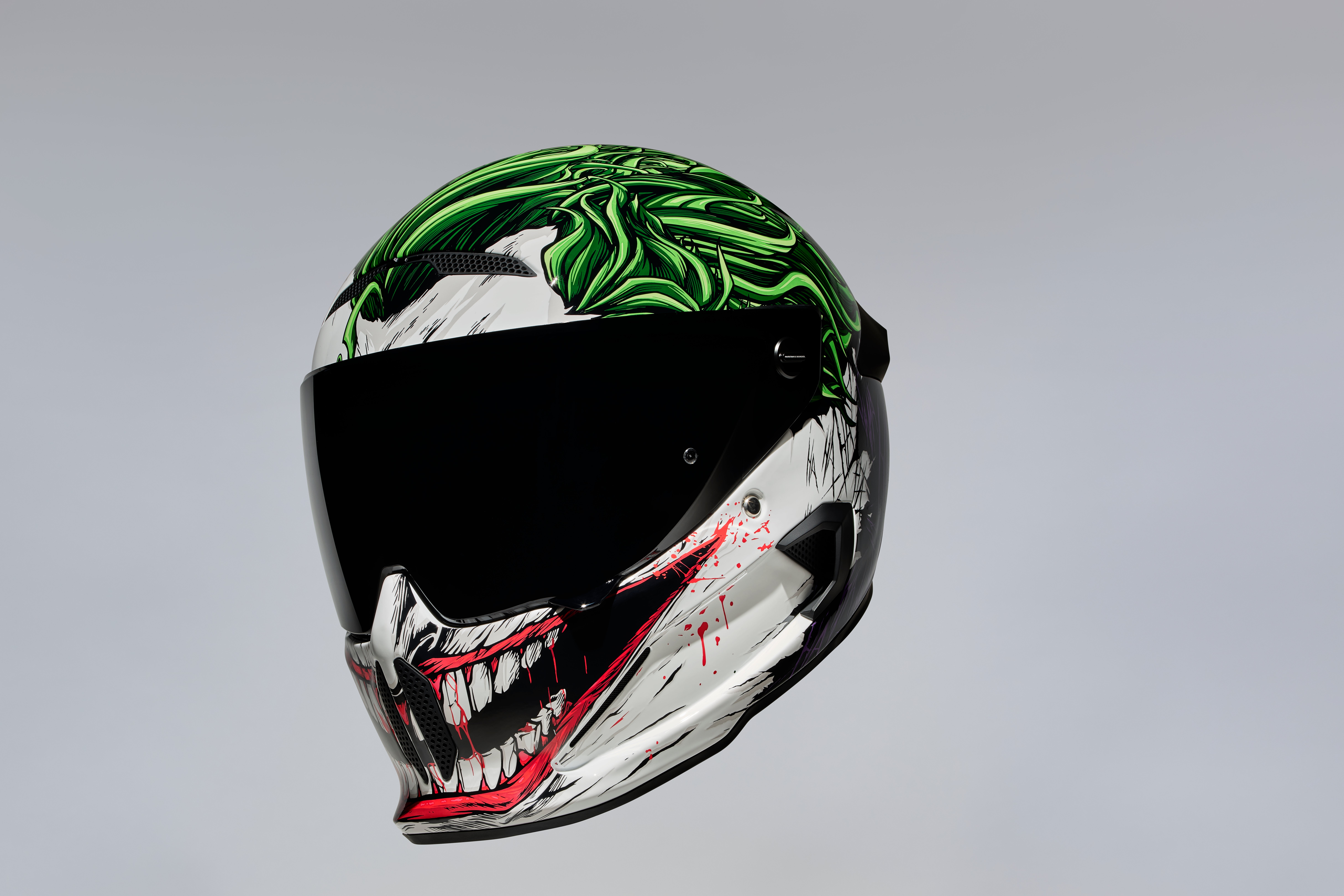
If you’ve ever been dazzled by wild crash helmet designs sported by a biker at the traffic lights, chances are they were wearing an Atlas, from a small UK-based firm you’ve probably never heard of.
Originally specialising in protective helmets for skiers and snowboarders, Ruroc moved into the motorcycle market in 2019 and - among those in the know - they’ve made quite a splash.
Most crash helmet makers do ‘special’ patterns that sell for around £100 or so above the cost of core, or basic designs. But Ruroc - based in Gloucestershire - goes further. Much further.
Often appealing to younger style-conscious riders, its portfolio pops and fizzes with serpents, flames, nightmarish ‘Joker’ characters, Halloween-style grotesques, even obscure references to sabre-toothed mythical beasts.
Fortunately for those of a more shrinking disposition Ruroc is widening its horizons, using the launch of its latest helmet - the Atlas 4.0, the very first UK-made helmet to meet the new, stricter EC 2206 safety certification rules - to introduce more sober, still eye-catching finishes too, probably in a bid to pull in slightly maturer riders.
Whatever your tastes, it’s as close as you can get to ordering a full-on customised helmet design without engaging a specialist artist at considerable cost.
Protection
It’s good timing, as Ruroc is simultaneously trumpeting something that also appeals to older riders - extra protection in a crash. This, says Ruroc, is thanks to a new energy-absorbing material being built into its helmets, which cost from £375 - £475.
‘Rheon’ was previously used only in Ruroc’s snowboarding helmets, and the material is claimed to reduce rotational forces on the head by up to 37 per cent. Now it’s going into their street helmets too - although you’ll have to remove the liner, if you want to see it.

Present at the launch of the Atlas 4.0 at the Bike Shed Motorcycle Club at London’s Old Street, was Ruroc’s Advanced Composites Engineer, Dr Ali Rabiee, who told me that Rheon is a ‘non-Newtonian’ fluid, a little like potty putty. It’s soft and malleable to the touch but if subjected to high velocity impacts - as in a motorcycle collision - it ‘stiffens’ to absorb the shockwaves that would otherwise be transmitted to the head.
This, Ruroc maintains, makes it perfect for crash helmets (Rheon is sandwiched between the ‘foam’ liner that sits directly on the rider’s head, and the EPS liner that sits next to the tough outer shell, made of Ruroc’s own carbon fibre mix) as it provides a comfortable, yielding liner.
So what else is new about the 4.0? Ruroc claims it is quieter, creating less turbulence, thanks to the removal of side vents (although they’ve retained dummy vents) and the addition of special sound-dampening inserts. There’s also a redesigned top vent switch, better overall venting, says Ruroc, and a new EPS structure (that part of the lining next to the outer shell, again) to make things safer. The Shockwave Bluetooth audio system has also been improved.

I tried one of Ruroc’s more understated designs, the ‘Mercury’ (£475), which is sensational, giving the appearance of being hewn from a solid block of brushed aluminium. Unusually, all Atlas 4.0s come with not just a clear visor (unchanged in design from the 3) but also a tinted visor, which, when fitted to the Mercury design, presents a truly badass look.
Style
Build quality feels good and solid - aided, paradoxically, by the weight of the helmet (it tips my kitchen scales at 1820 grammes with the audio system, 1775 without, so is not particularly light) - also by the paint finish, which is superb (what else would you expect of a firm that puts so much store on style).
The robust-feeling visor is exceptionally quick to mount or detach (requiring just two ‘thumb screws’), and the lining feels of a decent quality. I found I needed a Medium/Large, even though I’d normally be a Medium - these helmets come up small, so beware, if ordering.
The Atlas shuns traditional micro-ratchet or double-D ring fasteners, pioneering instead Ruroc’s own, magnetic Fidlock catch - which I find slightly awkward to use. No doubt time and practice would make it easier, with the benefit that it can be operated while wearing gloves.

On the head the Atlas 4.0 fits comfortably. Unfortunately, ‘mine’ turned out to be a Large, not the Medium which would have fitted better, slightly skewing results. On the move, the Atlas 4 is claimed by some reviewers to be quieter than the 3 (which I haven’t tried), and venting feels particularly breezy. The visor can be pulled down to a ‘detente’ position, leaving it cracked open just sufficiently to air your visor, but it can also be locked shut with a satisfying click. I shall revisit, and re-report with a small size soon.
Looks
The top vent catch is on the small side, making it slightly tricky to operate with thick gloves, while - strangely (it must be a looks thing) the slider for the chinbar vents is located inside the helmet, where it’s tricky to adjust on the move. They should move it.
At speed the helmet felt reasonably stable, and the visor is easy and positive to operate. Putting the helmet on and off was relatively easy (not always the case with some full face designs), although this was marred by ‘corners’ on the neck liner that caught on my forehead. If I were Ruroc, I’d smooth this out on future designs; images show that it wasn’t there on the Atlas 3.
Another slight dislike was for the prominent ‘nose’ (an inverted, upright ‘V’, on top of the chin guard) which I felt was visually intrusive, especially with the visor in place. It adds to that badass look that Ruroc customers clearly love, but at a cost to practicality.
What I particularly like is that Ruroc dares to be different and, being a small UK-based company (although international sales have climbed to 70,000 pa), it’s constantly evolving. I’d like to see further evidence of how Rheon is protecting riders’ heads in practice, and those minor snags, listed above, addressed, as the firm moves forward.

Maybe, in time, quality - already good - will become excellent. Currently, I’d put the fit, finish, and quality somewhere behind Shoei or Schuberth, but Rurocs are, of course, less costly, and offer an individuality not offered by those brands.
Ruroc has carved out quite a niche with its street art-style designs, which I like - even if I am too old to ride around London with a serpent on my head. I’d happily settle for the great, more muted Mercury look, however, and for the other shrinking violets out there it’s good to know that there are several other stunning - but less fantastical - designs to be mulled over, from this UK safety and style design house.
SOUND INVESTMENT
What makes Ruroc different is its approachability. The 150-employee firm engages with its audience in a way that most other helmet manufacturers don’t, creating a ‘clubby’ vibe, not least with its video archive, and 75,000-member Facebook Ruroc Motorcycle Gang. Ruroc is very hot on presentation too; your new helmet arrives in a beautifully-packaged box, and with an expensive-feeling storage bag.
Here www.ruroc.com/how-to-guides you can find clearly-explained advice on how to fit your Bluetooth system (they even admit it’s going to be a little tricky - it is), how to remove and replace the liner, how to remove a visor, and so on.
As for that £150 Bluetooth audio - it works very well. Sound quality is good and bassy (even if it was fiddly to fit, necessitating the removal of the entire liner). However the Shockwave unit should locate more securely in its housing; it pops out too easily when the charger is unplugged.
AUDIO OPTIONS
So you splashed out on your new Atlas 4.0, but can’t quite afford the Shockwave Bluetooth Audio. One solution is to trail earphones from your smartphone for sat-nav or music. Another is wireless earbuds which are less likely to get caught in your collar or neck tube.
The Atlas 4.0 has sufficient room around the ears, so I experimented with ONESONIC’s MXS-HD1 earbuds, complete with active noise cancelling, favoured by some riders as it reduces wind noise at speed, always a problem as it can cause long term hearing damage.

After a couple of false starts - putting on and taking off the helmet with the buds in place is tricky - they worked well, sending a stream of sat-nav directions as I negotiated London streets. If you select the best ear tips for a snug fit, the MXS-HD1s fit comfortably, allowing traffic sounds to get in, but largely sealing out wind roar.
Sound definition is good although the bass response is only average, and noise cancellation could be a lot better. The finish is high quality, and the MXS-HD1s incorporate volume controls, which need to be set before riding off. Battery life is around five hours from 1.5 hours of charging and a fully-charged case provides 20 hours of battery life. They are also claimed to be resistant to rain or sweat.
The neat tough, compact case is a major selling point. Take your helmet off carefully without allowing the buds to drop out (again, it requires practice) and store them safely in your pocket, ready for the next leg of the ride. Verdict? The £109.99 MXS-HD1s are not as efficient as a bespoke Bluetooth audio device, but it’s a less costly option - and one that gives listening pleasure off the bike too. But do adjust the volume and fit – it’s essential, with any audio, to be able to hear what’s going on around you. More at www.onesonic.co.uk.







